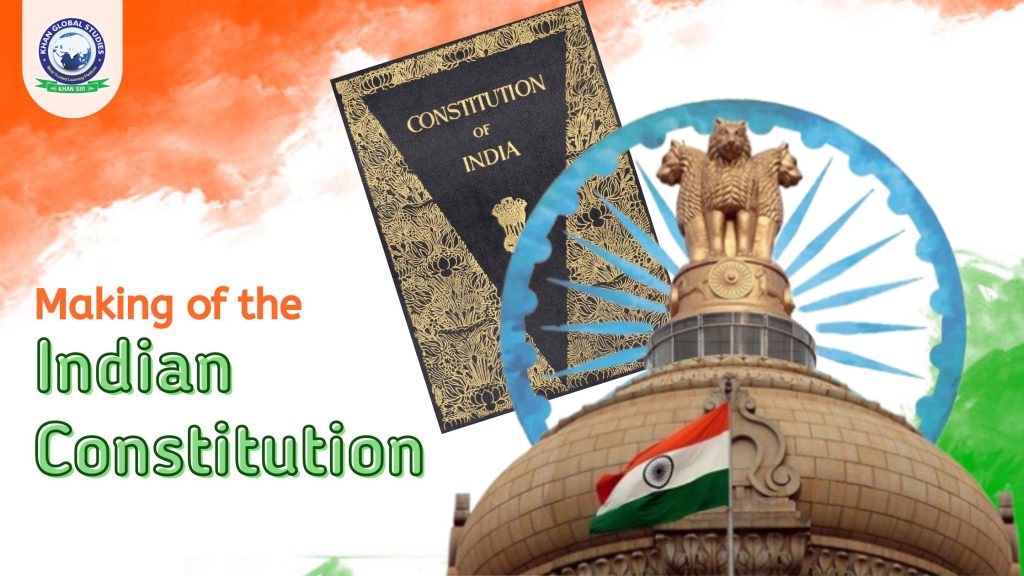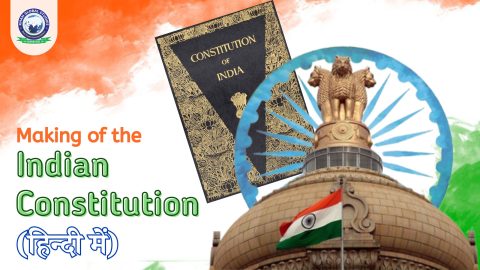The Constitution of India is admired globally because it is extremely complex and vast. It was not only drafted from the Indian perspective but also drew inspiration from the provisions of various constitutions across the world. It reflects the farsightedness and broad-mindedness of its framers, who were committed to establishing the country as a strong and prosperous democracy.
Considered as the supreme law of the land, the Indian Constitution emerged as the foundation of the Indian Republic after independence. It is not just a collection of legal orders but it embodies the soul of the nation and the shared ideals of its people.
Constitution Making Process
Drafting the Constitution was no easy task; it was the result of extensive deliberations and multi-layered discussions. The members of the Constituent Assembly attempted to balance ideologies, interests of various social classes and the rich cultural diversity of India. It embodies the values of the freedom struggle, the concept of social justice and national unity.
The Indian Constitution has a federal structure, delegating powers to both the central and state governments. Legislative, executive and judicial powers are distributed to prevent potential abuse of power, thereby ensuring that no single institution exercises absolute power. This structure maintains the democratic balance.
Making of the Constitution
The making of the Indian Constitution was an extensive and intensive task. The responsibility for this was entrusted to the Constituent Assembly established in 1946. Dr. Rajendra Prasad presided over the Assembly, while Dr. B.R. Ambedkar, the chairman of the drafting committee, is called the ‘architect’ of the Constitution.
In 1928, an all-party conference held in Lucknow to draft the Constitution produced the Nehru Report, which demanded a new Dominion status for British India and a federal system of government.
Many notable leaders, legal experts, social reformers and thinkers contributed to the constitution-making process. The Assembly comprised 299 members representing various political, social and cultural backgrounds. The Assembly took two years, eleven months and seventeen days to prepare the draft, during which it underwent complex debates and discussions.
The Constitution was formally adopted on November 26, 1949. It is the world’s longest written national constitution and came into force on January 26, 1950, the day now celebrated as Republic Day. While Dr Ambedkar’s contribution was enormous, Jawaharlal Nehru, Sardar Vallabhbhai Patel, Maulana Abul Kalam Azad and others also played important roles.
A unique aspect of the Constitution is that it was framed by the Constituent Assembly and not Parliament, which provides constitutional supremacy. Parliament cannot abolish the Constitution, which is based on the values of India’s freedom struggle, social justice and equality.
Who wrote the Constitution?
The original copy of the Constitution was handwritten by Prem Bihari Narayan Raizada, who did not charge any fee for his work. It took him six months to write the English version and he wrote his name on each page, adding the name of his guru and grandfather, Master Ram Prasad Saxena, on the last page. Raizada used more than 432 nibs to accomplish this task. Vasant Krishna Vaidya has written the Hindi copy.
Objective of the Constitution
The Preamble of the Constitution enunciates the basic ideals of justice, liberty, equality and fraternity, which are the pillars of Indian democracy. These principles define the fundamental rights and duties of its citizens. The Constitution provides Indian citizens with equality, equal opportunity and freedom from discrimination based on religion, caste, sex or place of birth.
A special feature of the Indian Constitution is that it is both rigid and flexible. It has provisions for amendment, which allow it to evolve, although some fundamental principles cannot be easily changed. This balance between flexibility and stability ensures that the Constitution remains relevant while maintaining its legal authority.
Why is a Constitution needed? (According to NCERT)
Why do we need a Constitution, and what does it do?
This can be understood from the example of South Africa. In this emerging democracy, both the oppressed and the oppressor were planning to co-exist with equal status. Trust between the two sides was not easily achieved, both were plagued by different kinds of fears. The majority blacks were cautious that the basic principle of majority rule in democracy should not be compromised, while the minority whites were fearful for their property and privileges.
After long negotiations, both sides agreed to a compromise. The whites accepted the principle of majority rule and one person, one vote. They also agreed to give basic rights to poor workers. In return, the blacks agreed that all decisions would not be taken by the majority alone, and they gave assurances that the property of the whites would not be confiscated. While reaching this agreement was difficult, implementing it was an even bigger challenge. The most important requirement was mutual trust. And even if trust was achieved, there was no guarantee that it would not be broken in the future.
The only way to build and maintain trust in such situations is to put these agreements in writing so that they are binding on everyone.
Rules about how future leaders will be chosen are set out in writing. The written document also states what an elected government can and cannot do, as well as the rights of citizens. These rules only work if those in power cannot change them easily or arbitrarily. South Africans ensured these safeguards by agreeing on some basic rules. They also agreed that these rules would be supreme and no government could ignore them. This written form of these basic rules is called the Constitution.
Constitution-making is not just limited to South Africa. All nations consist of different groups of people, and although their relationships may not be as antagonistic as the relationships between whites and blacks in South Africa, there are differences in interests and opinions around the world. All countries, whether democratic or not, need basic rules. This principle applies not just to governments but to any organisation – whether it is a local club, a cooperative society or a political party.
Features taken from different countries in the Indian Constitution
India has taken features of its constitution from many countries, the list of which is as follows:
| Names of Countries | Borrowed Features of the Constitution |
| Britain | 1. Parliamentary Government 2. Rule of Law 3. Legislative Procedure 4. Single Citizenship 5. Cabinet System 6. Privilege Writ 7. Parliamentary Privilege8. Bicameralism |
| Ireland | 1. Directive Principles of State Policy 2. Method of Election of President 3. Nomination of Members to Rajya Sabha by the President |
| United States of America | 1. Impeachment of the President 2. Functions of the President and Vice President 3. Removal of Judges of the Supreme Court and High Courts 4. Fundamental Rights 5. Judicial Review 6. Independence of the Judiciary 7. Preamble of the Constitution |
| Canada | 1. Centrifugal form of federalism, where the Centre is stronger than the states. 2. Residual powers are vested with the Centre 3. The Centre appoints governors to the states 4. Advisory jurisdiction of the Supreme Court |
| Australia | 1. Concept of Concurrent List 2. Article 108 i.e. Joint Sitting of both the Houses 3. Freedom of Trade and Commerce |
| USSR (now Russia) | 1. Fundamental Duties 2. Ideals of justice (social, economic and political), are expressed in the Preamble. |
| France | 1. The concept of “Republic” 2. The ideals of liberty, equality and fraternity (contained in the Preamble) |
| Germany | 1. Fundamental rights are suspended during an emergency. |
| South Africa | 1. Election of members of Rajya Sabha 2. Amendments to the Constitution |
| Japan | 1. The concept of “procedure established by law”. 2. Laws based on which the Supreme Court functions. |
Conclusion
The Indian Constitution is not just a legal document but a confluence of global constitutional practices. Through it, India has adopted the best practices that contribute to building a prosperous, inclusive and progressive nation. Its global outlook makes it a unique and commendable document, strongly demonstrating India’s commitment to democratic values and human rights.
In essence, the Indian Constitution is a living document, representing not just a legal framework but also the core of the nation’s identity. It stands as the cornerstone of the Republic and constantly strives to keep its citizens united, empowered and free. The diversity within the Indian Constitution reflects the diversity within the nation, respecting all castes, religions, languages and cultures, thus binding India as a unified nation.




